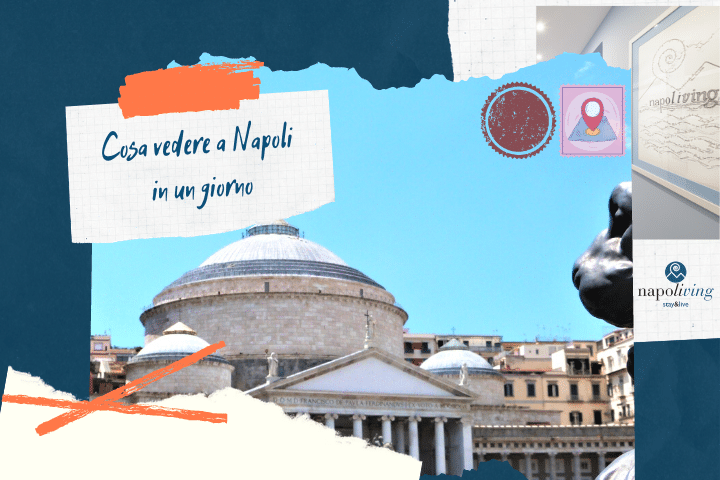Visiting Naples is a continuous surprise, because every corner is going to amaze you and leave you with wonderful memories.
A chaotic, noisy and cheerful city, able to welcome you as if you were at home and to put yourself at ease with the scent of the sea and the warmth of the sun on your skin.
Naples ignites your heart with its incredible beauty and, when you have just one day to spend there, you must select what to do with accuracy.
We have outlined a walking tour to guide you through the planning of that one day in Naples.
Moving from our Napoliving rooms, we are going to concentrate on the nearest tourist attractions in order to recommend a stroll to the discovery of the most famous places of interest.
Di cosa parliamo in questo articolo
Municipio Square: Angevin Keep and Fountain of Neptune
Our room are very close to Muncipio square – about 700 metres’ walk – one of the most important squares of Naples for the proximity of the harbour and for the presence of the impressive Angevin Keep.
The square is now named after the building where the municipality has its headquarters, but in the past the square was called Square of the Castle.
It was first shaped after 1537, when the new city walls were completed in place of the Aragonese ones.
It was just the beginning: the placement of the area was planned about the end of the 16th century by Domenico Fontana, and became usable by means of the levelling of the ground, staying the same until the Unification of Italy.
Over the centuries, the square has undergone several changes up to the present shape, also due to the end of the underground excavating works.
Municipio Square is surrounded by beautiful historical buildings, such as Teatro Mercadante and Palazzo San Giacomo, headquarters of the city hall, in which the church of San Giacomo degli Spagnoli has been incorporated.
Right at the centre of the gardens in front of the municipality, it is possible to see and take a picture of the majestic Fountain of Neptune, also called Medina Fountain.
It was viceroy Enrique de Guzmán’s desire, Count of Olivares, ruler in Naples from 1595 to 1599: the fountain was erected under the direction of Domenico Fontana.
The Fountain of Neptune is round-shaped, with four flight of steps opposing each other and decorated by fretworked tendrils on which 4 lions lay down.
They hold in their paws the shield of the city and of the Duke of Medina and Carafa, and water pours from their mouths.
Behind them, some crested newt and two sea monsters pour water in the central basin: it is a composition by Pietro Bernini, Gian Lorenzo’s father.
At the centre of the fountain, two nymphs and two satyrs together sustain on their head a goblet on which Neptune with its trident is on display.
In spite of the many stories to be told, your gaze will be drawn by the impressive New Castle, known as Angevin Keep.
It is a Medieval and Renaissance castle, symbol of the city, whose original core was built under the reign of Charles I of Anjou, after the moving of the capital from Palermo to Naples in 1266.
The Angevin Keep launched a museum itinerary back in 1990 and, still now, it leads from the fourteenth-century Palatine Chapel to the first and second level of the castle, going through the Armory Room.
On the first floor, noteworthy paintings by important Caravaggesque artists, such as Battistello Caracciolo and Fabrizio Santafede, and by famous exponents of Neapolitan Baroque – Luca Giordano, Francesco Solimena and Mattia Preti – are on display.
On the second floor, there are works from XVIII to XX centuries while other rooms of the castle (Charles V hall and Loggia hall) are intended to host temporary exhibitions.
San Carlo Theatre and Galleria Umberto I will come into your view while walking towards Plebiscito Square.
San Carlo Theatre and Galleria Umberto I
From Municipio Square, keep walking to Trieste e Trento Square.
Just before you reach it, you will find San Carlo Theatre on the left and one of the entrances to Galleria Umberto I on the right.
San Carlo Theatre is among the most famous opera theatres around the world, and it is the most ancient one still operative!
It was founded in 1737 with a seating capacity of 3,285, lowered to 1,386 over the years.
Many theatres have tried to recreate the structure and the style of the San Carlo but, at present, we can state with pride that it is still the favourite Italian stage for several opera singers and renowned stage actors.
In 1817, Stendhal wrote: “There is nothing all over Europe that comes close to this theatre or even gives the faintest idea…”
Opposite to the entrance of San Carlo Theatre, there is one out of four entrances to Galleria Umberto I, a shopping arcade built between 1887 and 1890.
The area in which it is located was a tangle of overcrowded and bad-reputed alleys, where inns and houses of ill fame showed up.
There is no wonder that even 9 cholera epidemics broke out here between 1835 and 1884, and they later on involved a governmental intervention in order to restore the city to a healthy condition.
The successful project was the construction of a four-branches arcade, covered by a dome.
The inside of Galleria Umberto I has recently undergone restoration work, which has recreated the original aspect of the decorative sculpture, the imposing busts and the peculiar Art Nouveau decorations.
After visiting the Galleria, come out in Trieste e Trento square to enjoy a coffee in the famous Gambrinus Café, a historical Art Nouveau bar.
It preserves stuccos, statues and paintings of the late XIX century by important Neapolitan artists.
Gran Caffè Gambrinus (its full name) was a leg for many “Grand Tour”, cultural initiation voyages for young European aristocrats between XVII and XVIII centuries.
After sipping your coffee, go for a stroll up to near Plebiscito Square.
Plebiscito Square and Royal Palace
Plebiscito Square is a symbol of Naples. San Francesco di Paola Church, the Royal Palace, the Palace of the Prefecture and Salerno Palace overlook it.
Pedestrian area is the optimum to stop and enjoy:
- the statues of Neapolitan kings inside the eight recesses built by Vanvitelli on the facade of the Royal Palace;
- the majestic equestrian statues depicting Charles III and Ferdinand I, the former by Canova and the latter partly (the horse) by Canova before dying and then by his pupil Antonio Calì.
When in the square, right beside the Royal Palace, it is possible to see Vesuvius from the little viewpoint overlooking the seafront.
Since time is not enough, we suggest you enjoy the view for a while and then go on and visit the Royal Palace.
Designed by Domenico Fontana in 1600 and fully completed by Luigi Vanvitelli, together with other artists, it was the residence for Spanish viceroys for over 150 years.
It now hosts the National Library, a very evocative place, but royal apartments and gardens are still open to the public.
Once out of Royal Palace, go back to Trieste e Trento Square to take Toledo Street.
Toledo Street and the most beautiful underground in Europe
Toledo Street, also known as Roma Street, is a main arterial road in Naples. It is famous for big-brand stores.
It was commissioned by viceroy Pedro Alvarez de Toledo in 1536, and now it is a pedestrian area – up to Armando Diaz Street – with historical buildings, noble palaces, churches and shops running along it, among which:
- Palazzo Zevallos, hosting a museum gallery included in the Italian Galleries, property of Intesa Sanpaolo banking group;
- the church of St. Nicholas the Charitable, hosting works of art by the major painters of the Neapolitan XVIII century.
Strolling around Toledo Street, peek into the alleys running along it with their unforgettable views and a lot of Neapolitan folklore, like in Quartieri Spagnoli.
This area is experiencing a real tourist renovation since the opening of the near underground station of Toledo Street, acknowledged as the most beautiful one in Europe.
The station displays a marine theme, indeed you will feel like walking underwater and embraced by classical music, blue-white lights and mosaic.
Going down the escalator, you will find the sea gallery by Bob Wilson, named “By the sea… you and me”: a mosaic-like and marine-theme environment where water references are tangible.
Walking along Toledo Street, you will reach Dante Square.
Dante Square and Port’Alba
Dante Square is one out of the most famous squares of Naples and its historical centre.
It is located at the very beginning of Toledo Street and, due to the entrance to Port’Alba, it is connected to Decumanus Maggiore.
Up until 1588, it was known as Largo Mercatello (which means “Little Market Square”) to differentiate it from the bigger and more ancient market held in Mercato Square.
The present shape of the square dates back to the second half of the XVIII century, by the architect Luigi Vanvitelli, to whom “Foro Carolino” – a commemorative monument for the king Charles – was commissioned
The result was a big hemicycle, incorporating Port’Alba on the left and San Michele church on the right.
From 1834, the central recess of the building represents the entrance to the Jesuit boarding school, which became the National Boarding School Vittorio Emanuele II in 1861.
The area took the name “Piazza Dante” in 1871, when the statue of Dante Alighieri was built by the sculptors Tito Angelini and Tommaso Solari Junior.
Also, there are 4 monumental churches overlooking the square:
- church of Immacolata degli Operatori Sanitari;
- church of Santa Maria di Caravaggio;
- church of San Domenico Soriano;
- church of San Michele a Port’Alba.
As said above, Port’Alba is an ancient entrance to the city of Naples and owes its name to don Antonio Álvarez de Toledo, duke of Alba and Spanish viceroy, which had it built in 1625.
The door was built in order to facilitate the passage for everyone, since an unofficial hole (“pertuso”) had been opened on the ancient Angevin walls to allow people to reach some villages more easily.
Beyond the door, there is the famous Port’Alba Street, the road of libraries, surrounded by XVIII century buildings.
If you are not tired yet, go on and take Decumanus Maggiore, enjoy the historical centre and reach your Napoliving room simply by walking.
Otherwise, take the underground in Piazza Dante – towards Garibaldi Station – and get off at University stop, 100 metres from Napoliving.

Insegnante di lingua e letteratura inglese per la scuola secondaria, traduttrice e correttrice di bozze. Coltivo con devozione e premura l’interesse per la cultura giapponese, e nutro tutte le mie altre creature con la stessa cura: libri, film, musica. Viaggio tanto, ma resto figlia di Partenope.

